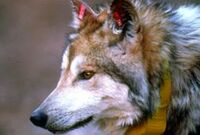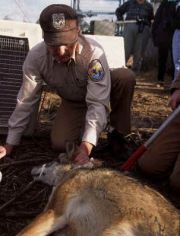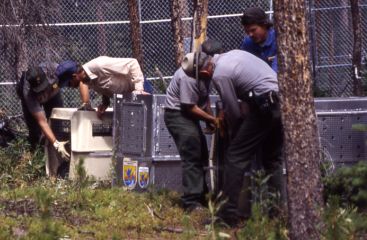Wolf reintroduction
Wolf reintroduction involves the artificial reestablishment of a population of wolves into areas where they had been previously extirpated. Wolf reintroduction is only considered where large tracts of suitable wilderness still exist and where certain prey species are abundant enough to support a predetermined wolf population.
After years of review and discussion, wolves have been reintroduced to different areas in the United States. Currently, wolf reintroduction is being deliberated for a few other locations in the U.S. and also in many European countries. In most cases both now and in the past, the debate pits people in urban and rural areas against one another, with the latter tending to be against predator reintroductions citing concerns for local ranching industries. However, many people have undergone a change in attitude toward wolves and other predators, especially over the past few decades. As a result, wolf reintroduction proponents, incited by a greater awareness of the important ecological niche wolves have as keystone predators, usually represent the majority, which has been the most important factor where wolf reintroduction has already succeeded.
Gray Wolf Reintroduction
Yellowstone National Park and Idaho
Wolf packs were reintroduced to Yellowstone National Park and Idaho (U.S. state) starting in 1995. These wolves were considered as “experimental, non-essential” populations per article 10(j) of the Endangered Species Act (ESA). Such classification gave government officials greater leeway in dealing with problem wolves, which was considered one of a series of compromises wolf reintroduction proponents made with concerned local ranchers.
The idea of wolf reintroduction was first brought to Congress in 1966 by biologists who were concerned with the critically high elk population in Yellowstone was having an adverse effect on the park's vegetation. Officially, 1926 was the year the last wolves were killed within Yellowstone’s boundaries, and over the succeeding decades, populations of elk and other large prey animals had soared, and new growth vegetation suffered as a result. Moreover, coyotes tried to fill in the niche left by wolves, but were unable to control the large ungulate populations. Booming coyote numbers, furthermore, also had a negative effect on other species, particularly the red fox.

Adolescent members from packs of Mackenzie Valley wolves in Alberta, Canada were tranquilized and carted down to the recovery zones later that week, but a last minute court order delayed the planned releases. The stay came from an appellate court in Denver and was instigated by the Wyoming Farm Bureau. After spending an additional 36 hours in transport cages inside the recovery zones, the wolves were finally released following official judicial sanction. Yellowstone’s wolves stayed in acclimation pens for two more months before being released into the wild. Idaho’s wolves, conversely, were given a hard release. A total of 66 wolves were released to the two areas in this manner in January 1995 and January 1996.
2005 estimates of wolf populations in the two recovery zones reflect the success the species has had in both areas:
- Greater Yellowstone Area: 325
- Central Idaho: 565
These numbers, added with the estimated number of wolves in northwestern Montana (130), puts the total number of wolves in the Northern Rocky Mountains recovery area at over 1000 individuals. This includes approximately 134 packs (two or more wolves traveling together) and 71 breeding pairs (male and female that successfully rear a litter of at least two until Dec. 31). The recovery goal for the area was 30 breeding pairs total, and this number has been surpassed for some time. [1]
The reintroduction of wolves has reportedly increased biodiversity within Yellowstone National Park. Along with (and partly because of) an increase in new-growth vegetation which has resulted from the reduction in elk numbers, beaver (which had also become extinct from the park) and red fox populations have recovered, probably due to the wolves keeping coyote populations under control.[2] Reintroduction has also had a profound economic effect, with over 40 thousand people taking wolf tours in Yellowstone and Idaho. Yellowstone economists estimate that wolf watchers will add over 100 million dollars to the Yellowstone area economy over the next twenty years. [3]
Opposition to Yellowstone Reintroduction
Ranchers were steadfastly opposed to reintroducing a species of animal that they considered to be analogous to a plague, citing the hardships that would ensue with the potential loss of stock caused by wolves.
Local industry and environmental groups battled for years over the Yellowstone and Idaho wolf reintroduction effort. The government, which was charged with creating, implementing, and enforcing a compromise, struggled for over two decades to find middle ground. A wolf recovery team was appointed in 1974, and the first official recovery plan was released for public comment in 1982. General public apprehension regarding wolf recovery forced the U.S. Fish and Wildlife Service to revise their plan to implement more control for local and state governments, so a second recovery plan was released for public comment in 1985. That same year, a poll conducted at Yellowstone National Park showed that 74% of visitors thought wolves would improve the park, while 60% favored reintroducing them. The preparation of an environmental impact statement, the last critical step before reintroduction could be green-lighted, was halted when Congress insisted that further research be done before an Environmental Impact Statement (EIS) was to be funded.
In 1987, in an effort to shift the burden of financial responsibility from ranchers to the proponents of wolf reintroduction, Defenders of Wildlife set up a “wolf compensation fund” that would use donations to pay ranchers market value for any stock that was lost to wolf depredation. That same year, a final recovery plan was released. Following a long period of research, public education, and public commenting, a draft EIS was released for public review in 1993 and it received over 150,000 comments from interested parties. It was finalized in May 1994, and included a clause that specified that all wolves reintroduced to the recovery zones would be classified under the “experimental, non-essential” provision of the ESA. Though the original plan called for three recovery zones – one in Idaho, another in Montana, and a final one in the Greater Yellowstone Area – the Montana recovery zone was eliminated from the final EIS after it had been proven that a small, but breeding population had already established itself in the northwestern part of the state.
A pair of lawsuits filed in late 1994 put the whole recovery plan in jeopardy. Interestingly, while one of the lawsuits was filed by the Wyoming Farm Bureau, the other was filed by a coalition of concerned environmental groups. The latter pointed to unofficial wolf sightings as proof that wolves had already migrated down to Yellowstone from the north, which, they argued, made the plan to reintroduce an experimental population in the same area unlawful. According to their argument, if wolves were already present in Yellowstone, they should rightfully be afforded full protection under the ESA, which, they reasoned, was preferable to the limited “experimental” classification that would be given to any reintroduced wolves. [4]
Nevertheless, both cases were thrown out on January 3, 1995. Since wolves have been recovered, there have been hundreds of confirmed incidents of livestock depredation, though such predation represents a minute proportion of a wolf’s diet on a per wolf basis. While the majority of wolves ignore livestock entirely, a few rogue wolves or wolf packs will become chronic livestock depredators, and will either be relocated or killed depending on the area and number of incidents. Since the year Defenders of Wildlife implemented their compensation fund, they have allocated over $500,000 to private owners for proven and probable livestock depredation by wolves.
In Sweden and Norway, there has been a long and ongoing conflict between some groups whose belief it is that wolves no longer have a place in nature and those who wish the wolf to be allowed to expand out into more of the area’s vast boreal forests. The former mostly consists of members of the rural working class who fear competition for certain large ungulate species (Roe Deer, moose, etc.), and who consider the wolf to be a foreign element. They argue that modern Scandinavian wolves are actually recent migrants from Russia and not the remnants of old native wolf packs, which, they reason, is why they don’t belong in Sweden and Norway. Recent DNA research seems to support this claim.
Scandinavian wolves had been nearly completely eliminated from the range due to extirpation campaigns in the nineteenth and twentieth centuries, and were considered to be gone from the area by the 1960s. In the early 1980s, however, a single breeding pack was discovered in southern Sweden, over 1000 km away from the nearest known population in Russia or Eastern Finland. The pack was small – about ten animals – and it stayed that way for many years until its population began to noticeably increase starting in 1991. Prior to 1991, the small population lacked ideal genetic diversity, and inbreeding had been occurring to a potentially dangerous degree. Furthermore, low birth rates suggest that the wolves were apprehensive to mate with each other, which was most likely due to their close relation. Genetic data suggests that, in 1991, a lone immigrant wolf from Russia migrated to the area and single-handedly restored genetic diversity to the population. A particular study showed that of the 72 wolves born between 1993 and 2001, 68 of them could trace their genetic heritage to this lone migrant wolf. Today, there are over one hundred individuals that range across this southern area of Scandinavia. [5] The population remains genetically isolated, however, which is a cause of concern for some. On the other hand, there is reason to believe that as the number of wolves living in this area increases, the boundaries of the population's range will creep towards the ranges of other, separate populations in Finland, thus promoting dispersal. Direct reintroduction remains an intriguing option to foster genetic diversity in the Scandinavian population in the meantime.
There has been much speculation as to how the original population came to be in the early 80s. Some believe that they might be a native species – remnants of a population that somehow survived persecution. Much genetic research has been performed on this population, however, and this particular theory isn’t supported by the findings. Genetic analysis seems to support the idea that the wolves were immigrants that had traveled over 1000 km from Russia to southern Scandinavia along one of several possible dispersal routes. Certain conspiracy theorists believe that they were artificially reintroduced per some secret agenda by the Swedish government. [6]
Since the wolves have reestablished themselves, Norwegian and Swedish farmers have complained of sheep and dog depredation. Indeed, many ranchers in Norway were forced to give up their practice once local wolves discovered sheep as potential prey. This exemplifies the general trend that the people who are usually the most skeptical about wolf recovery, though they typically represent the minority, are also the ones most directly affected by it. Most of the proponents of wolf reintroduction in Norway and Sweden can be found in urban populations, which is a pattern that can be seen wherever wolf reintroduction is a hot button issue. As a result, some are calling for the legalization of hunting wolves in this area. European Union regulation doesn't make this an option in Sweden. However, government action could be taken to cull wolf populations if either of the two countries involved should sanction such action.
Mexican Wolf Reintroduction
Arizona

The five last known wild Mexican grey wolves were captured in 1980 in accordance with an agreement between the United States and Mexico intended to save the critically endangered species. Since then, a comprehensive captive breeding program has brought the subspecies back from the brink. Currently, there are 300 captive Mexican wolves taking part in the program.
The ultimate goal for these wolves, however, is to reintroduce them to areas of their former range. In March 1998, this reintroduction campaign began with the releasing of three packs into the Apache-Sitgreaves National Forest in Arizona. Today, there may be up to 50 wild Mexican wolves in Arizona and New Mexico. The final goal for Mexican wolf recovery is a wild, self-sustaining population of at least 100 individuals. [7]
Red Wolf Reintroduction
Louisiana and Texas

The red wolf was hunted nearly to extinction and the last red wolves were reduced to a marginal habitat in Louisiana and Texas, where they bred with coyotes and suffered heavy parasite infestation. The red wolf was listed as endangered in 1967 according to the ESA and a captive breeding program at the point Defiance Zoological Gardens in Tacoma, Washington (U.S. state) was established in November 1973. The United States Fish and Wildlife service captured over 400 red wolves from southwestern Louisiana and southeastern Texas from 1973 to 1980. Fieldwork from the USFWS found that many red wolf coyote hybrids among the captured animals were common and in order to determine the genetic integrity of the wolves’ measurements, vocalization analyses, and skull X rays were used to differentiate red wolves from coyotes and red wolf-coyote hybrids. 43 out of the original 400 captured animals were believed to be red wolves and were immediately sent to the breeding facility. Further testing concluded that only 14 of the original 400 captured animals were actually pure red wolves and became the breeding group for the reintroduction.
63 red wolves were released on 76 occasions from October 1987 to December 1994. Radio colors were used to monitor the wolves and to judge the success of the reintroduction. Biologists were able to determine the outcomes of 93% of the releases of captive born wolves and the fates of 77% of the wild born wolves. Biologists stated that only 21% of the releases with known outcomes were successful. Restoration of the red wolf population allowed biologists to study many aspects of red wolf biology and served as an important reference for future reintroductions.
Central and Western Europe
In several areas in Europe, reintroduction of wolves to areas where they have become extinct is being actively considered. Charities in many European countries including Denmark, Germany, Italy and Scotland are also advocating the reintroduction of wolves to specific rural and forested areas. Most plans have been met with a mixture of enthusiasm and unease by different population groups. Proponents argue reintroduction would benefit tourism and ecological diversity while opponents fear the loss of livestock that may result from their reintroduction. In several countries, charity based compensation schemes (similar to those which operate in the USA) have been proposed.[8]
References
- ↑ USFWS. Rocky Mountain Wolf Recovery 2005 Interagency Annual Report. Retrieved on May 3, 2006.
- ↑ "Lessons from the Wolf -- Bringing the top predator back to Yellowstone has triggered a cascade of unanticipated changes in the park's ecosystem". Retrieved on May 24, 2006.
- ↑ The Wolf Almanac – Robert H. Busch The Lyons Press, New York
- ↑ Defenders of Wildlife. A Yellowstone Chronology. Retrieved on May 3, 2006.
- ↑ ‘’Nature’’. Conservation biology: Lone wolf to the rescue. Retrieved on May 4, 2006.
- ↑ ‘’Wildlife Biology’’. The origin of the southern Scandinavian wolf ‘’Canis Lupus’’ population. Retrieved on May 4, 2006.
- ↑ USFWS. Mexican Grey Wolf Fact Sheet. Retrieved on May 4, 2006.
- ↑ ‘’Wolf Trust: understanding of wolves & natural heritage of Scottish Highlands’’. Retrieved on May 24, 2006.
Primary Sources
Mech, David L and Luigi Boitani Wolves Behavior, Ecology, and Conservation The University of Chicago Press, 2004

